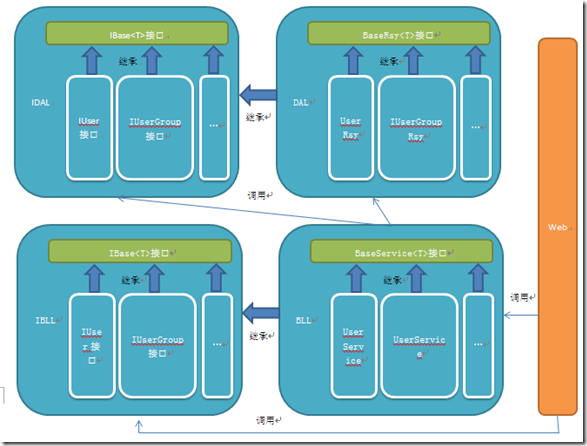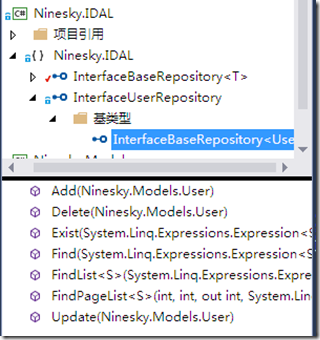前面項目的層次和調用關系都說明了,關系如下圖

采用三層架構的時候,研究過BLL層的必要性,覺得業務邏輯完全可以在controller裡實現,沒有必要單獨做一個項目,另一個分層多了會影響性能。後來我還是把業務邏輯獨立出來,原因如下:
對於性能我覺得分層多了肯定會有影響,但是不會很大。現在硬件的更新速度遠大於軟件,對業務邏輯處理起來很輕松,多實例化幾個類對性能影響不大。一般來說網站運行基本上是一個存數據庫和取數據庫的過程,業務邏輯還是比較少,只不過現在的網站使用的圖片、動畫更多,效果更加絢麗。我覺得網站的效率瓶頸主要出現在服務器的帶寬、IO性能和存取數據庫上。在代碼方面能做的就是優化數據庫的存取。對了一般項目來說,為了百分之幾的運行效率遠不如提高開發效率和更加容易的代碼管理重要,能實現需求就好,運行效率是哪是大牛要做的事。
對IDAL、DAL、IBLL 、BLL這四個項目:
IDAL寫一個Base接口,接口中固定幾個數據庫操作方法,其他接口都繼承自這個接口;
DAL項目做個base類實現這個IDAL的base接口,其他類都繼承自base類。
同樣IBLL中也寫一個Base接口,固定幾個基本的操作方法,同樣其他接口也繼承自這個base接口
IBLL中也寫一個base類來實現IBLL中的base接口,其他類繼承自這個base類。
這裡以對用戶的操作來構建代碼的基本模式:
一、模型
這裡寫三個模型類。打開Ninesk.Models分別添加User、UserGroup、UserConfig三個模型類。
1、用戶模型—User類
用戶模型或者叫賬戶模型,為什麼這麼說看下面代碼
using System;
using System.ComponentModel.DataAnnotations;
namespace Ninesky.Models
{
/// <summary>
/// 用戶模型
/// <remarks>
/// 創建:2014.02.02<br />
/// 修改:2014.02.05
/// </remarks>
/// </summary>
public class User
{
[Key]
public int UserID { get; set; }
/// <summary>
/// 用戶名
/// </summary>
[Required(ErrorMessage="必填")]
[StringLength(20,MinimumLength=4,ErrorMessage="{1}到{0}個字符")]
[Display(Name="用戶名")]
public string UserName { get; set; }
/// <summary>
/// 用戶組ID
/// </summary>
[Required(ErrorMessage = "必填")]
[Display(Name = "用戶組ID")]
public int GroupID { get; set; }
/// <summary>
/// 顯示名
/// </summary>
[Required(ErrorMessage = "必填")]
[StringLength(20, MinimumLength = 2, ErrorMessage = "{1}到{0}個字符")]
[Display(Name = "顯示名")]
public string DisplayName { get; set; }
/// <summary>
/// 密碼
/// </summary>
[Required(ErrorMessage = "必填")]
[Display(Name = "密碼")]
[DataType(DataType.Password)]
public string Password { get; set; }
/// <summary>
/// 郵箱
/// </summary>
[Required(ErrorMessage = "必填")]
[Display(Name = "郵箱")]
[DataType(DataType.EmailAddress)]
public string Email { get; set; }
/// <summary>
/// 用戶狀態<br />
/// 0正常,1鎖定,2未通過郵件驗證,3未通過管理員
/// </summary>
public int Status { get; set; }
/// <summary>
/// 注冊時間
/// </summary>
public DateTime RegistrationTime { get; set; }
/// <summary>
/// 上次登陸時間
/// </summary>
public DateTime LoginTime { get; set; }
/// <summary>
/// 上次登陸IP
/// </summary>
public DateTime LoginIP { get; set; }
public virtual UserGroup Group { get; set; }
}
}
這個模型類中只包含用戶名、密碼、用戶組、顯示名、郵箱等屬性,純粹是基本的賬戶信息,目的是讓用戶注冊的時候盡可能的少填信息。其他信息如果需要可以再寫新類與賬戶進行關聯,用戶需要的時候登錄後再進行補填(如:資本資料、個人信息、聯系方式等。這裡先不考慮這些)。這裡的顯示名根據需要可以做昵稱、真實姓名等來使用。
2、用戶組模型—UserGroup類
這個類注意下GroupType,這個用來對用戶組進行一下分類的,方便管理,其實沒什麼特別的意義。我的想法是普通類型就放普通的注冊用戶的組,如果大的網站允許用戶升級的話,限定在這個類型的用戶組內。特權組可以放一些vip之類的用戶組,需要管理員給予,區別普通用戶組,但又沒有管理權。管理類型的用戶組需要後台管理員給予,可以對文章、評論、咨詢進行管理。
using System.ComponentModel.DataAnnotations;
namespace Ninesky.Models
{
/// <summary>
/// 用戶組
/// <remarks>
/// 創建:2014.02.02
/// 修改:2014.02.08
/// </remarks>
/// </summary>
public class UserGroup
{
[Key]
public int GroupID { get; set; }
/// <summary>
/// 名稱
/// </summary>
[Required(ErrorMessage="必填")]
[StringLength(20, MinimumLength = 2, ErrorMessage = "{1}到{0}個字")]
[Display(Name="名稱")]
public string Name { get; set; }
/// <summary>
/// 用戶組類型<br />
/// 0普通類型(普通注冊用戶),1特權類型(像VIP之類的類型),3管理類型(管理權限的類型)
/// </summary>
[Required(ErrorMessage = "必填")]
[Display(Name = "用戶組類型")]
public int GroupType { get; set; }
/// <summary>
/// 說明
/// </summary>
[Required(ErrorMessage = "必填")]
[StringLength(50, ErrorMessage = "少於{0}個字")]
[Display(Name = "說明")]
public string Description { get; set; }
}
}
3、用戶配置模型類—UserConfig類
這個類是一些用戶配置信息(暫時只考慮了注冊設置),在後台管理員處進行設置。
using System.ComponentModel.DataAnnotations;
namespace Ninesky.Models
{
/// <summary>
/// 用戶配置
/// <remarks>
/// 創建:2014.02.06
/// </remarks>
/// </summary>
public class UserConfig
{
[Key]
public int ConfigID { get; set; }
/// <summary>
/// 啟用注冊
/// </summary>
[Display(Name = "啟用注冊")]
[Required(ErrorMessage="必填")]
public bool Enabled { get; set; }
/// <summary>
/// 禁止使用的用戶名<br />
/// 用戶名之間用“|”隔開
/// </summary>
[Display(Name = "禁止使用的用戶名")]
public string ProhibitUserName { get; set; }
/// <summary>
/// 啟用管理員驗證
/// </summary>
[Display(Name = "啟用管理員驗證")]
[Required(ErrorMessage = "必填")]
public bool EnableAdminVerify { get; set; }
/// <summary>
/// 啟用郵件驗證
/// </summary>
[Display(Name = "啟用郵件驗證")]
[Required(ErrorMessage = "必填")]
public bool EnableEmailVerify { get; set; }
/// <summary>
/// 默認用戶組Id
/// </summary>
[Display(Name = "默認用戶組Id")]
[Required(ErrorMessage = "必填")]
public int DefaultGroupId { get; set; }
}
}
二、數據存儲層
數據存儲層負責與數據庫打交道,由於使用了接口產生了兩個項目DAL和IDAL。IDAL是接口項目,DAL是接口的實現項目。
在與數據庫的方便有一些共同的操作,像添加、修改、刪除、查詢等。不想在實際寫代碼的時候在用戶類寫一遍這些東西,用戶組類再寫一遍、以後文章、評論都再重復寫這些代碼。怎麼辦,弄個基類。以後其他類從基類繼承就把這些公共方法繼承過來了。
1、IDAL項目
首先打開IDAL項目,添加類InterfaceBaseRepository,代碼如下。
using System;
using System.Linq;
using System.Linq.Expressions;
namespace Ninesky.IDAL
{
/// <summary>
/// 接口基類
/// <remarks>創建:2014.02.03 <br />
/// 修改:2014.02.09</remarks>
/// </summary>
/// <typeparam name="T">類型</typeparam>
public interface InterfaceBaseRepository<T>
{
/// <summary>
/// 添加
/// </summary>
/// <param name="entity">數據實體</param>
/// <returns>添加後的數據實體</returns>
T Add(T entity);
/// <summary>
/// 查詢記錄數
/// </summary>
/// <param name="predicate">條件表達式</param>
/// <returns>記錄數</returns>
int Count(Expression<Func<T, bool>> predicate);
/// <summary>
/// 更新
/// </summary>
/// <param name="entity">數據實體</param>
/// <returns>是否成功</returns>
bool Update(T entity);
/// <summary>
/// 刪除
/// </summary>
/// <param name="entity">數據實體</param>
/// <returns>是否成功</returns>
bool Delete(T entity);
/// <summary>
/// 是否存在
/// </summary>
/// <param name="anyLambda">查詢表達式</param>
/// <returns>布爾值</returns>
bool Exist(Expression<Func<T, bool>> anyLambda);
/// <summary>
/// 查詢數據
/// </summary>
/// <param name="whereLambda">查詢表達式</param>
/// <returns>實體</returns>
T Find(Expression<Func<T, bool>> whereLambda);
/// <summary>
/// 查找數據列表
/// </summary>
/// <typeparam name="S">排序</typeparam>
/// <param name="whereLamdba">查詢表達式</param>
/// <param name="isAsc">是否升序</param>
/// <param name="orderLamdba">排序表達式</param>
/// <returns></returns>
IQueryable<T> FindList<S>(Expression<Func<T, bool>> whereLamdba, bool isAsc, Expression<Func<T, S>> orderLamdba);
/// <summary>
/// 查找分頁數據列表
/// </summary>
/// <typeparam name="S">排序</typeparam>
/// <param name="pageIndex">當前頁</param>
/// <param name="pageSize">每頁記錄數</param>
/// <param name="totalRecord">總記錄數</param>
/// <param name="whereLamdba">查詢表達式</param>
/// <param name="isAsc">是否升序</param>
/// <param name="orderLamdba">排序表達式</param>
/// <returns></returns>
IQueryable<T> FindPageList<S>(int pageIndex, int pageSize, out int totalRecord, Expression<Func<T, bool>> whereLamdba, bool isAsc, Expression<Func<T, S>> orderLamdba);
}
}
這裡定義了增、刪、改、判斷存在、返回模型的查詢、返回集合的查詢,返回分頁集合的查詢7個公共方法。這幾個方法基本滿足一般需要,特殊的方法在繼承的時候再添加。
還使用了泛型,在繼承的時候傳入實體類型就可以直接繼承這些方法了。具體看下InterfaceUserRepository接口就清楚了。
using Ninesky.Models;
namespace Ninesky.IDAL
{
/// <summary>
/// 用戶接口
/// <remarks>創建:2014.02.03</remarks>
/// </summary>
public interface InterfaceUserRepository:InterfaceBaseRepository<User>
{
}
}
簡單吧,繼承自InterfaceBaseRepository接口並傳入實體類User就行了。我們在類視圖中看下,是不是繼承了基類的接口。

2、DAL項目
DAL項目是對IDAL項目接口的實現,項目中要創建DbContext類,對於DbContext類很多人討論過它對數據庫存取的效率,MSDN中說其是輕量的, 創建不需要很大開銷,它也不是線程安全的對象,並且具有數據容器的性質(跟蹤),因此很多人認為不應該將其靜態化、單例化。但是對用戶的單次請求來說實現DbContext唯一是合理的。 先看代碼吧,非常簡單。
using Ninesky.Models;
using System.Data.Entity;
namespace Ninesky.DAL
{
/// <summary>
/// 數據上下文
/// <remarks>創建:2014.02.03</remarks>
/// </summary>
public class NineskyDbContext:DbContext
{
public DbSet<User> Users { get; set; }
public DbSet<UserGroup> UserGroups { get; set; }
public DbSet<UserConfig> UserConfig { get; set; }
public NineskyDbContext()
: base("DefaultConnection")
{
}
}
}
下面創建一個BaseRepository類,繼承自InterfaceBaseRepository並實現類其接口的方法。
using Ninesky.IDAL;
using System;
using System.Linq;
using System.Linq.Expressions;
namespace Ninesky.DAL
{
/// <summary>
/// 倉儲基類
/// <remarks>創建:2014.02.03</remarks>
/// </summary>
public class BaseRepository<T>: InterfaceBaseRepository<T> where T : class
{
protected NineskyDbContext nContext = ContextFactory.GetCurrentContext();
public T Add(T entity)
{
nContext.Entry<T>(entity).State = System.Data.Entity.EntityState.Added;
nContext.SaveChanges();
return entity;
}
public int Count(Expression<Func<T, bool>> predicate)
{
return nContext.Set<T>().Count(predicate);
}
public bool Update(T entity)
{
nContext.Set<T>().Attach(entity);
nContext.Entry<T>(entity).State = System.Data.Entity.EntityState.Modified;
return nContext.SaveChanges() > 0;
}
public bool Delete(T entity)
{
nContext.Set<T>().Attach(entity);
nContext.Entry<T>(entity).State = System.Data.Entity.EntityState.Deleted;
return nContext.SaveChanges() > 0;
}
public bool Exist(Expression<Func<T, bool>> anyLambda)
{
return nContext.Set<T>().Any(anyLambda);
}
public T Find(Expression<Func<T, bool>> whereLambda)
{
T _entity = nContext.Set<T>().FirstOrDefault<T>(whereLambda);
return _entity;
}
public IQueryable<T> FindList<S>(Expression<Func<T, bool>> whereLamdba, bool isAsc, Expression<Func<T, S>> orderLamdba)
{
var _list = nContext.Set<T>().Where<T>(whereLamdba);
if (isAsc) _list = _list.OrderBy<T, S>(orderLamdba);
else _list = _list.OrderByDescending<T, S>(orderLamdba);
return _list;
}
public IQueryable<T> FindPageList<S>(int pageIndex, int pageSize, out int totalRecord, Expression<Func<T, bool>> whereLamdba, bool isAsc, Expression<Func<T, S>> orderLamdba)
{
var _list = nContext.Set<T>().Where<T>(whereLamdba);
totalRecord = _list.Count();
if (isAsc) _list = _list.OrderBy<T, S>(orderLamdba).Skip<T>((pageIndex - 1) * pageSize).Take<T>(pageSize);
else _list = _list.OrderByDescending<T, S>(orderLamdba).Skip<T>((pageIndex - 1) * pageSize).Take<T>(pageSize);
return _list;
}
}
}
代碼中都是對數據庫的操作。比較有看頭的是這句protected NineskyDbContext nContext = ContextFactory.GetCurrentContext();
ContextFactory是一個簡單工廠類,GetCurrentContext()是一個靜態函數。利用簡單工廠獲取請求內的當前DbContext,也就是請求內的DbContext單例。先添加一個工廠類ContextFactory
using System.Data.Entity;
using System.Runtime.Remoting.Messaging;
namespace Ninesky.DAL
{
/// <summary>
/// 上下文簡單工廠
/// <remarks>
/// 創建:2014.02.05
/// </remarks>
/// </summary>
public class ContextFactory
{
/// <summary>
/// 獲取當前數據上下文
/// </summary>
/// <returns></returns>
public static NineskyDbContext GetCurrentContext()
{
NineskyDbContext _nContext = CallContext.GetData("NineskyContext") as NineskyDbContext;
if (_nContext == null)
{
_nContext = new NineskyDbContext();
CallContext.SetData("NineskyContext", _nContext);
}
return _nContext;
}
}
}
這裡是先在CallContext中獲取NineskyContext,如果為空則初始化一個NineskyContext,如果存在則直接返回。看CallContext,MSDN中講CallContext提供對每個邏輯執行線程都唯一的數據槽,而在WEB程序裡,每一個請求恰巧就是一個邏輯線程所以可以使用CallContext來實現單個請求之內的DbContext單例。
下面添加具體的倉儲代碼。
在DAL中再添加一個UserRepository類,繼承自BaseRepository和InterfaceUserRepository。目的是繼承自BaseRepository類,實現InterfaceUserRepositor接口。
using Ninesky.IDAL;
using Ninesky.Models;
using System.Linq;
namespace Ninesky.DAL
{
/// <summary>
/// 用戶倉庫
/// <remarks>創建:2014.02.03</remarks>
/// </summary>
class UserRepository: BaseRepository<User>, InterfaceUserRepository
{
}
}
UserRepository就直接繼承了基類中的方法,基類中的方法能滿足絕大部分需要,UserRepository就不用再增加函數了,其他Repository類都類似,不在貼代碼了。
這裡我們在建一個Repository工廠,用來返回項目中的所有Repository類。
using Ninesky.IDAL;
namespace Ninesky.DAL
{
/// <summary>
/// 簡單工廠?
/// <remarks>創建:2014.02.03</remarks>
/// </summary>
public static class RepositoryFactory
{
/// <summary>
/// 用戶倉儲
/// </summary>
public static InterfaceUserRepository UserRepository { get { return new UserRepository(); } }
}
}
以後在BLL中調用的時候就不用每次都寫InterfaceUserRepository _iUserRsy = new UserRepository()了,直接寫成InterfaceUserRepository _iUserRsy = RepositoryFactory.UserRepository這個東西的好處就是,以後在DAL項目中實現InterfaceUserRepository接口的類需要修改時我們可以直接創建個新類,然後RepositoryFactory類中讓UserRepository屬性返回新類就行了。
3、IBLL項目
IBLL是業務邏輯層的接口,業務邏輯層對數據庫的操作上基本還是增、刪、改。同樣寫一個基接口把這三個操作寫進去,這裡與IDAL思路類似。
namespace Ninesky.IBLL
{
/// <summary>
/// 接口基類
/// <remarks>創建:2014.02.03</remarks>
/// </summary>
public interface InterfaceBaseService<T> where T : class
{
/// <summary>
/// 添加
/// </summary>
/// <param name="entity">數據實體</param>
/// <returns>添加後的數據實體</returns>
T Add(T entity);
/// <summary>
/// 更新
/// </summary>
/// <param name="entity">數據實體</param>
/// <returns>是否成功</returns>
bool Update(T entity);
/// <summary>
/// 刪除
/// </summary>
/// <param name="entity">數據實體</param>
/// <returns>是否成功</returns>
bool Delete(T entity);
}
}
在添加一個InterfaceUserService接口,繼承自InterfaceBaseService。根據需要在接口中又添加了幾個方法。在這裡對Find方法的名稱進行統一,凡是返回實體類的名稱為Find()或FindByXXX(),返回一組數據的方法名稱為FindList()或FindXXXList,分頁的名稱格式為FindPageList()或FindxxxPageList()
using Ninesky.Models;
using System.Linq;
namespace Ninesky.IBLL
{
/// <summary>
/// 用戶相關接口
/// <remarks>
/// 創建:2014.02.09
/// </remarks>
/// </summary>
public interface InterfaceUserService:InterfaceBaseService<User>
{
/// <summary>
/// 用戶是否存在
/// </summary>
/// <param name="userName">用戶名</param>
/// <returns>布爾值</returns>
bool Exist(string userName);
/// <summary>
/// 查找用戶
/// </summary>
/// <param name="userID">用戶ID</param>
/// <returns></returns>
User Find(int userID);
/// <summary>
/// 查找用戶
/// </summary>
/// <param name="userName">用戶名</param>
/// <returns></returns>
User Find(string userName);
/// <summary>
/// 用戶列表
/// </summary>
/// <param name="pageIndex">頁碼數</param>
/// <param name="pageSize">每頁記錄數</param>
/// <param name="totalRecord">總記錄數</param>
/// <param name="order">排序:0-ID升序(默認),1ID降序,2注冊時間升序,3注冊時間降序,4登錄時間升序,5登錄時間降序</param>
/// <returns></returns>
IQueryable<User> FindPageList(int pageIndex, int pageSize, out int totalRecord,int order);
}
}
4、BLL項目
BLL項目中要實現InterfaceUserService接口的方法,先添加BaseService的
using Ninesky.IBLL;
using Ninesky.IDAL;
namespace Ninesky.BLL
{
/// <summary>
/// 服務基類
/// <remarks>創建:2014.02.03</remarks>
/// </summary>
public abstract class BaseService<T> : InterfaceBaseService<T> where T : class
{
protected InterfaceBaseRepository<T> CurrentRepository { get; set; }
public BaseService(InterfaceBaseRepository<T> currentRepository) { CurrentRepository = currentRepository; }
public T Add(T entity) { return CurrentRepository.Add(entity); }
public bool Update(T entity) { return CurrentRepository.Update(entity); }
public bool Delete(T entity) { return CurrentRepository.Delete(entity); }
}
}
這個類的構造函數中要傳入一個參數就是currentRepository 這個在繼承的時候進行傳入。這裡還是看用戶類。
using Ninesky.DAL;
using Ninesky.IBLL;
using Ninesky.Models;
using System.Linq;
namespace Ninesky.BLL
{
/// <summary>
/// 用戶服務類
/// <remarks>
/// 創建:2014.02.12
/// </remarks>
/// </summary>
public class UserService:BaseService<User>,InterfaceUserService
{
public UserService() : base(RepositoryFactory.UserRepository) { }
public bool Exist(string userName) { return CurrentRepository.Exist(u => u.UserName == userName);}
public User Find(int userID) { return CurrentRepository.Find(u => u.UserID == userID); }
public User Find(string userName) { return CurrentRepository.Find(u => u.UserName == userName); }
public IQueryable<User> FindPageList(int pageIndex, int pageSize, out int totalRecord, int order)
{
switch(order)
{
case 0: return CurrentRepository.FindPageList(pageIndex, pageSize, out totalRecord, u => true, true, u => u.UserID);
case 1: return CurrentRepository.FindPageList(pageIndex, pageSize, out totalRecord, u => true, false, u => u.UserID);
case 2: return CurrentRepository.FindPageList(pageIndex, pageSize, out totalRecord, u => true, true, u => u.RegistrationTime);
case 3: return CurrentRepository.FindPageList(pageIndex, pageSize, out totalRecord, u => true, false, u => u.RegistrationTime);
case 4: return CurrentRepository.FindPageList(pageIndex, pageSize, out totalRecord, u => true, true, u => u.LoginTime);
case 5: return CurrentRepository.FindPageList(pageIndex, pageSize, out totalRecord, u => true, false, u => u.LoginTime);
default: return CurrentRepository.FindPageList(pageIndex, pageSize, out totalRecord, u => true, true, u => u.UserID);
}
}
}
}
上面這個FindPageList代碼太累贅了,一時還沒想到好方法。
5、總結
今天寫到這裡還是在想項目間的調用實現,寫了兩個base接口、兩個base類,以後其他的類都從它們繼承,寫法都很類似。下次可以開始做界面了,在Ninesky.Web項目中基本上是通過IBLL,BLL跟數據進行打交道了。
===================================================
FindPageList() 這個排序的方法確實不太通用,代碼修改如下:
1、接口 InterfaceBaseRepository
修改兩個接口方法如圖紅框部分。
image
2、BaseRepository類
添加OrderBy方法,代碼如下:
/// <summary>
/// 排序
/// </summary>
/// <typeparam name="T">類型</typeparam>
/// <param name="source">原IQueryable</param>
/// <param name="propertyName">排序屬性名</param>
/// <param name="isAsc">是否正序</param>
/// <returns>排序後的IQueryable<T></returns>
private IQueryable<T> OrderBy(IQueryable<T> source, string propertyName, bool isAsc)
{
if (source == null) throw new ArgumentNullException("source", "不能為空");
if (string.IsNullOrEmpty(propertyName)) return source;
var _parameter = Expression.Parameter(source.ElementType);
var _property = Expression.Property(_parameter, propertyName);
if (_property == null) throw new ArgumentNullException("propertyName", "屬性不存在");
var _lambda = Expression.Lambda(_property, _parameter);
var _methodName = isAsc ? "OrderBy" : "OrderByDescending";
var _resultExpression = Expression.Call(typeof(Queryable), _methodName, new Type[] { source.ElementType, _property.Type }, source.Expression, Expression.Quote(_lambda));
return source.Provider.CreateQuery<T>(_resultExpression);
}
修改FindList和FindPageList方法,修改下圖
image
3、修改UserService的FindPageList方法
修改後的代碼如下:
public IQueryable<User> FindPageList(int pageIndex, int pageSize, out int totalRecord, int order)
{
bool _isAsc = true;
string _orderName = string.Empty;
switch(order)
{
case 0:
_isAsc = true;
_orderName = "UserID";
break;
case 1:
_isAsc = false;
_orderName = "UserID";
break;
case 2:
_isAsc = true;
_orderName = "RegistrationTime";
break;
case 3:
_isAsc = false;
_orderName = "RegistrationTime";
break;
case 4:
_isAsc = true;
_orderName = "LoginTime";
break;
case 5: _isAsc = false;
_orderName = "LoginTime";
break;
default:
_isAsc = false;
_orderName = "UserID";
break;
}
return CurrentRepository.FindPageList(pageIndex, pageSize, out totalRecord, u => true, _orderName, _isAsc);
}
以上就是ASP.NET MVC5 網站開發框架模型、數據存儲以及業務邏輯的相關介紹,比之前兩節的內容是不是更加豐富了,希望本文可以對大家的學習有所幫助。